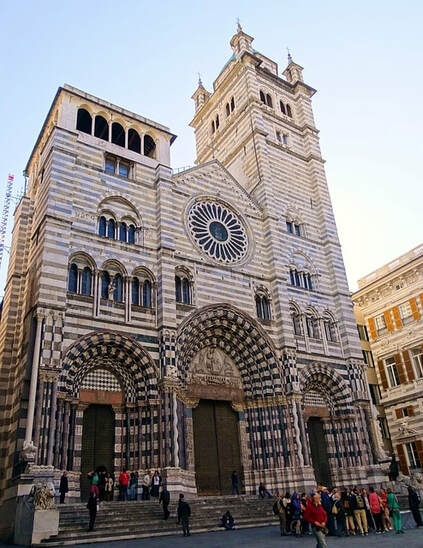Remnants of an ancient power
The Genoa of the past lies today in the harbour and the medieval quarter. The Palazzo San Giorgio is located on the seafront and was once the headquarters of the Banco San Giorgio, one of Europe’s most powerful financial houses in the middle ages. Founded by the rich merchants of the city, the bank served not only private businesses but also Kings and Queens. It consists of two parts — one distinctly medieval and the other dating from the renaissance. The inside contains five chests which held the reports about the bank’s five offices, which were essentially feedback about how well the branches were operating. The building included a dungeon which served as a prison, and it is in this dungeon that Marco Polo, a Venetian prisoner of war, dictated his account of the great voyage of travel to China.
While the Palazzo still faces the seashore, the seashore itself is now much changed. Designed by Renzo Piano, the new waterfront is aimed to revitalize Genoa’s maritime districts, in line with Genoa’s designation as European Cultural City for 2004. Industrial development from the early 19th century onwards had changed much of the atmosphere of the waterfront from the medieval buildings, but in their own way maintained Genoa’s status as a leading seaport in Italy.
With great wealth, the city could afford good works such as church building. Among the many medieval churches, the Cathedral of San Lorenzo stands above all others. It bears a resemblance to the famous Cathedral of Pisa, with the same horizontal stripe pattern. The church was consecrated in 1118, but has been much rebuilt over the years as a result of wars which have ravaged the city through its history. A particularly noteworthy incident was when a British shell fired during the Second World War miraculously failed to explode, thus failing to do serious damage to the church. Like many major medieval churches, it is associated with several saints. It is said to be the burial ground of saint John the Baptist, and a reliquary of St. Anne forms part of its treasure. It is also unique in that it contains a treasury of items procured during its long career as a commercial power, many with fantastic stories and claims of supernatural properties.
Doges and Military Dictators

Like in Venice, political power in Genoa soon passed into the hands of the Doge, who effectively ruled the republic as chief of state. A grand official seat was built on the land lying between the churches of San Matteo and San Lorenzo. The Grimaldina Tower is believed to predate the palace and was part of a prison compound. Many artists were jailed here and they have left frescoes on the walls. The Torre del Popolo built in 1539 dominates the old city. Major extension works added a great hall, a pair of grand staircases leading to the first floor and a chapel. In the days of the Republic, the Doge would lead a procession of officers to the Council Halls up the Western flight of the staircase.
Throughout its life as an independent city, Genoa was under constant threat of invasion from larger foreign powers. It faded as a power but rallied under the leadership of Andrea Doria. An orphan who became a mercenary, Andrea Doria fought often to keep Genoa independent while helping the French in their fight against the forces of the Hapsburgs. The Palazzo Principe, located in Fassalo, was built by Andrea by combining several buildings already located on property that he acquired. A new court was carved out at the palace, and the palace features unique architecture as it was built over a very long period of time. Like many grand public buildings, this palace features a grand staircase leading to a loggia with five arches. This loggia connects the apartments of Andrea and his wife, located on the second floor of the palace.
The remnants of the walls and gates of the medieval city still remain in many parts of town. The Porta dei Vacca is a narrow arch over a pedestrian street, flanked by two cylindrical towers. Today, the gateway appears as if it is incorporated into the surrounding buildings. Another gateway, similar in appearance, is the Porta Soprana. Over time, the exertions of remaining independent proved too much even for these massive gates and towers to uphold, and so today, they remain as memorials to a glorious past, even as Genoa continues as a major port of modern Italy.